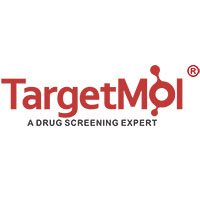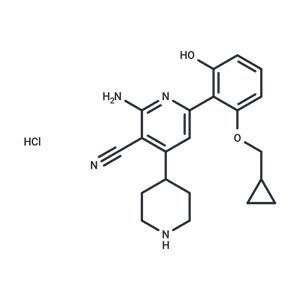| Name | ACHP Hydrochloride |
| Description | ACHP Hydrochloride (IKK-2 Inhibitor VIII) is a highly potent and selective inhibitor of IKK-β with an IC50 of 8.5 nM. |
| Cell Research | HTLV-1-infected T-cell lines, ATL-35T, 81-66/45, MJ, and MT-2 cells, human ATL cell lines established from ATL patients, ATL-102, ED-40515(?) and TL-Om1 cells, and an HTLV-1-negative T-cell leukemia cell line Jurkat are used in this study. Approximately 1.5×10^4 cells are cultured in 96-well plates in triplicates at 37°C. Growth inhibitory effect of ACHP (0.01, 0.1, 1, 5, 10, 50 and 100 μM) is determined using MTT assay. Optical densities (OD) at 570 and 630?nm are measured with a multi-plate reader. Cell viability (%) is calculated [2]. |
| Animal Research | In vivo arachidonic acid-induced ear edema in mice: ear edema is induced by topical application of arachidonic acid (500 μg/ear). ACHP (0.3, 1 and 3 mg/kg, p.o.), Dexamethasone, and vehicle (10% cremophor in saline) are given po 60 min before the arachidonic acid application. Ear thickness is measured at 0, 1, 3, and 6 h after the arachidonic acid application [1]. |
| In vitro | ACHP Hydrochloride (Compound 4j) exhibits potent IKK-β inhibitory (IC50: 8.5 nM) and cellular activities (IC50: 40 nM, in A549 cells), moderately inhibits IKK-α (IC50: 250 nM), and demonstrates selectivity against other kinases such as IKK3, Syk, and MKK4 (IC50>20,000 nM). It inhibits NF-κB-dependent reporter gene activation in TNFα-activated HEK293 cells and PMA/calcium ionophore-activated Jurkat T cells but does not inhibit PMA-induced AP-1 activation in MRC-5 cells or PMA/calcium ionophore-induced NF-κB-dependent reporter gene transcription in Jurkat cells even at concentrations exceeding 10 μM. ACHP selectively interferes with the NF-κB signaling cascade by inhibiting IKK-β in living cells and inhibits their growth dose-dependently. Tax-active cell lines are more susceptible to ACHP than Tax-inactive cell lines and Jurkat (IC50 values in Tax-active cell lines, Tax-inactive cell lines, or Jurkat are 3.1±1.3 μM, 10.7±1.7 μM, and 23.6 μM, respectively), suggesting that the growth of Tax-active cells depends on NF-κB more than Tax-inactive cells [1][2]. |
| In vivo | ACHP is orally bioavailable in mice (BA: 16%) and rats (BA: 60%), with significant in vivo activity in anti-inflammatory models (arachidonic acid-induced mouse ear edema model). It has reasonable aqueous solubility (0.12 mg/mL in pH 7.4 isotonic buffer), excellent Caco-2 permeability (Papp 62.3×10^-7 cm/s), and low clearance in rats (0.33 L/h/kg). In an acute inflammation model, ACHP demonstrates oral efficacy at 1 mg/kg in a dose-dependent manner [1]. |
| Storage | Powder: -20°C for 3 years | In solvent: -80°C for 1 year | Shipping with blue ice/Shipping at ambient temperature. |
| Solubility Information | 10% DMSO+40% PEG300+5% Tween 80+45% Saline : 2 mg/mL (4.99 mM), Sonication is recommended.
DMSO : 45 mg/mL (112.25 mM), Sonication is recommended.
|
| Keywords | IκB kinase | IκB | Inhibitor | inhibit | IKKβ | IKKα | IKK | IkB/IKK | IkB | I kappa B kinase | ACHP Hydrochloride | ACHP |
| Inhibitors Related | WS3 | Amlexanox | Malachite green oxalate | Rosmarinic acid | SC-514 | Resveratrol | Bardoxolone Methyl | GSK8612 | BX795 | CCCP | Allicin | Vinpocetine |
| Related Compound Libraries | NF-κB Signaling Compound Library | Bioactive Compound Library | Kinase Inhibitor Library | Anti-Ovarian Cancer Compound Library | Anti-Breast Cancer Compound Library | Inhibitor Library | Anti-Fibrosis Compound Library | Anti-Aging Compound Library | Immunology/Inflammation Compound Library | Bioactive Compounds Library Max | Covalent Inhibitor Library | Anti-Cancer Compound Library |

 United States
United States



